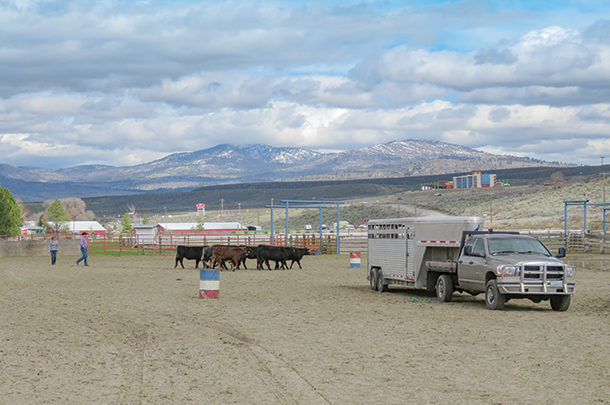For cattle producers, a stock trailer to haul a sick animal to the vet, move pairs to pasture or transport variable cargo is a necessary and basic piece of equipment. When upgrading or purchasing, practical features should be considered, including asking questions about how animal welfare relates to unit selection.
The correlation between stock trailers and health is dependent on how they’re used, says Chris Schachtschneider, livestock and rangeland extension specialist with Oregon State University.
“Cattle handling while loading and unloading affects health,” Schachtschneider says. “Cleanliness is also critical to well-being. There’s no ‘one size fits all’ when it comes to choosing the right unit.”
Size, metal and terrain
Schachtschneider explains that selection of steel or aluminum can be based on content of normally hauled loads, but terrain is an even greater factor. In Texas, he notes, narrow, long trailers are often more effective, as they tend to match road size. Numbers also affect choices. Using a gooseneck to run 1,200 head might not be as efficient as using a semitrailer. For ranches consistently hauling into tight areas with plenty of sharp corners, smaller equipment might be required.
“Size is dependent on the operation,” he says. “Large trailers make sense traveling down the road between feedlots, whereas for those running cows up a mountain, we might not see anything more than 24 feet.”
Steel frames may stand up better in rough country as they’re slightly stronger and normally cheaper to buy, but they are also prone to rust in hot and humid climates. Aluminum models’ lighter weight will lower fuel consumption, but they tend to be more expensive.
Doug Dean, livestock and range extension agent for the Colorado State University Tri-River area and Western Slope, says aluminum trailers are more resistant to manure and urine and make excellent highway units, being easier to pull. If running gas-powered trucks rather than diesel, pulling sizeable steel trailers may be a challenge. In these cases, Dean recommends aluminum bodies.
“If the luxury of owning more than one trailer exists, having a steel unit for rougher pastures as they tend to flex more in brush and uneven conditions, and aluminum for highway use might be the way to go,” he says. “Of course, this isn’t always feasible, so it becomes a buyer’s preference.”
Gates, latches and partitions
Dean says gates, latches and partitions are key to reliability. When working with excitable cattle, trustworthy slam gates are crucial, as workers need to be confident they’ll hold. Front compartments for young or sick calves, a horse or even to keep stock dogs safe from bigger animals are also excellent features.
“For those over a certain length, one to three dividers are standard design, but it’s important they’re as close as possible to floor-to-ceiling height,” says Ashley Wright, associate area agent for the University of Arizona Cooperative Extension. “Just as essential, as well as latching properly across the width of the body, they need to secure flat against the side walls when not in use. Cattle can be injured if they swing freely during transit.”
To make use of partitions, Wright encourages producers to load trailers to their suitable capacity, not overcrowding or underfilling. Too many animals squeezed together increases the chances of falling and being unable to get up. Hauling too few leads to increased chances of bruising.
“Cattle help support each other,” she says. “A single cow in an open space doesn’t have others to keep her upright. This makes for a riskier situation.”
Flooring and ventilation
Wright believes sturdy, non-slip flooring is crucial, as unstable footing often leads to injuries and bruising from falls. Floor options include wood, textured aluminum or steel, spray-on liners and various types of rubber mats. Metal floors can be slippery, but adding shavings helps with footing and cleanout by keeping manure from sticking. Mats are beneficial but are an extra cost.
“Disinfection is vital,” she stresses. “If hauling treated culls followed by calves that are more susceptible to disease, disinfect between loads. Follow disinfectant label instructions, including the contact time with a surface. A downside of mats is they’re heavy and awkward to handle. Wood floors, while relatively non-slip, can also be difficult to disinfect completely.”
Ventilation also needs to be factored in dependent on area climate. For hot, dry regions, a typical design is open or barred roofs to maintain cooler temperatures while traveling. For colder, snowy or wet areas, it’s critical to block significant drafts, but ventilation slats are still important, as cattle generate their own heat.
Operator skills and livestock training
Wright says when purchasing a new unit, buyers must match the gross vehicle weight rating, plus the amount of fully loaded cargo to the tow vehicle. The total should never exceed towing capacity.
She urges operators to drive with care, keeping in mind if animals are free-standing, balancing alone or with hundreds or even thousands of pounds bumping into them.
“Follow speed limits and leave plenty of stopping distance,” she advises. “Slow down and accelerate gently, and turn slowly and predictably. Anything we do to provide an easier ride will be beneficial from a stress and welfare perspective.”
Schachtschneider believes that even more significant than trailer selection are handling practices related to loading and unloading. He encourages producers to spend time with their cattle, especially replacement heifers, teaching them what’s expected. Over time, an entire herd will be filled with trained animals that understand normal routines.
“It doesn’t take a lot of extra energy,” he says. “If we handle them consistently and gently, it provides an opportunity to teach them, have them go through gates, move single file, pass by a handler in an alley without panicking. So when we load a trailer, cattle aren’t rushing, piling up, or bruising themselves by falling down or hitting their hips into corners.”
While matching a stock trailer to an operation isn’t a straightforward, cookie-cutter task, a wide variety of sizes, materials and design options are available to make the selection easier. The choice will help this essential piece of equipment become an efficient and productive partner in a livestock operation.












